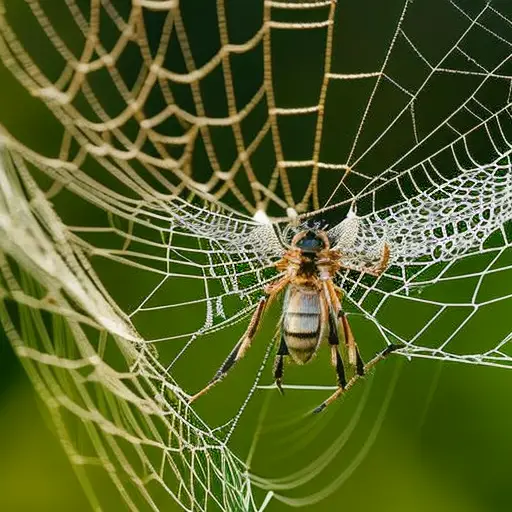The Role of Insects in Wilderness Survival

In the vast expanse of the wilderness, where survival hinges on resourcefulness, humans have long relied on the innumerable gifts of nature. Amidst the towering trees and untamed landscapes, insects play a pivotal role in our ability to endure.
They offer sustenance, medicine, and even fire starting capabilities. These tiny creatures, often overlooked, possess a wealth of survival knowledge waiting to be unearthed.
This article delves into the scientific, informative, and practical aspects of the significant role insects play in our wilderness survival.
Food Source
In wilderness survival scenarios, insects can serve as a reliable and readily available source of sustenance, often providing a regularly accessible food option. Insect farming has gained attention as a sustainable and efficient way to produce food in certain regions. Insects are rich in proteins, fats, and essential nutrients, making them a valuable nutritional resource. They are also abundant and diverse, with over 2,000 edible species documented worldwide.
Culinary uses of insects have been practiced in various cultures throughout history. Insects can be cooked, roasted, fried, or ground into powder to be used as an ingredient in different dishes. They can provide unique flavors and textures to culinary creations, and their consumption is becoming increasingly popular in some Western countries as well.
Insect farming has the potential to address food security issues, as it requires minimal resources and produces less greenhouse gas emissions compared to traditional livestock farming. Additionally, insects can be fed organic waste, reducing the environmental impact of food waste disposal.
While many insects are safe to consume, it is essential to identify and avoid poisonous species. Proper preparation and cooking methods are crucial to ensure food safety. Insect farming and culinary utilization offer promising solutions to meet the growing demand for sustainable and nutritious food sources, particularly in remote or resource-limited environments.
Water Procurement
Continuing the exploration of survival strategies, the procurement of water in wilderness settings is of paramount importance. When faced with limited water sources, insects can offer unique solutions for obtaining potable water. Here are three intriguing ways in which insects contribute to water procurement:
-
Insect-based water filtration: Certain insects, such as the water striders, possess hydrophobic legs that allow them to walk on water surfaces. They also have specialized structures that enable them to filter out contaminants, making the water they reside on relatively clean. By observing and emulating their behavior, humans can learn how to filter water in a similar manner, reducing the risk of waterborne diseases.
-
Insect behavior in drought conditions: Insects have adapted various survival strategies to thrive in arid environments. Some species, like desert beetles, have the ability to extract moisture from the air using specialized grooves on their exoskeleton. By studying these insects, we can learn innovative techniques to collect water from the atmosphere, especially in areas with low humidity.
-
Insect-made water sources: Insects, such as bees and ants, construct elaborate structures like hives and nests that can store water. These reservoirs can be tapped into by humans when other sources are scarce or inaccessible.
Understanding the role of insects in water procurement is crucial for wilderness survival. However, insects also possess other remarkable attributes, such as medicinal properties, which will be explored in the following section.
Medicinal Properties
Building upon the exploration of water procurement in wilderness survival, the discussion now turns to the medicinal properties exhibited by insects. Insect-based remedies have long been used in traditional medicine for their natural healing properties. These remedies are becoming increasingly popular due to their effectiveness and minimal side effects.
Insects produce a wide range of chemical compounds that can be used for medicinal purposes. From antibacterial and antifungal agents to anti-inflammatory and analgesic compounds, insects offer a diverse array of therapeutic options. These natural substances can be extracted from various parts of the insect, including the exoskeleton, venom, and secretions.
To illustrate the potential medicinal value of insects, consider the following table:
| Insect | Medicinal Property |
|---|---|
| Honeybees | Antibacterial |
| Silk moths | Wound healing |
| Ants | Anti-inflammatory |
| Beetles | Pain relief |
The use of insect-based remedies in wilderness survival can provide a valuable resource for treating common ailments such as infections, wounds, and pain. By harnessing the power of nature, individuals can rely on these natural healing properties when traditional medicine is not readily available. However, caution should always be exercised, and it is advisable to consult with a healthcare professional before using any insect-based remedies.
Fire Starting
Fire starting in wilderness survival can be a challenging task, but insects can provide valuable assistance.
Insects, such as dry grasshoppers or beetles, can serve as excellent tinder sources due to their dry and flammable nature.
Additionally, certain insects, like the cottonwood borer larvae, can be used as kindling to increase the chances of starting a fire.
Utilizing insects in fire starting not only enhances the efficiency of the process but also highlights the resourcefulness and adaptability of survival techniques in the wild.
Insect-Based Tinder Sources
In the realm of wilderness survival, insects play a crucial role as an abundant and reliable source of tinder for starting fires. When traditional tinder sources are scarce or unavailable, insect-based alternatives can be a lifesaver.
Here are three insect-based tinder sources and fire starting techniques that can be employed in emergency situations:
-
Insect exoskeletons: The exoskeletons of certain insects, such as beetles and ants, contain flammable compounds that can be used as tinder. By collecting and crushing these exoskeletons, a small pile of fine, dry powder can be obtained, which easily catches fire when ignited.
-
Insect nests: Insect nests, such as those built by wasps and bees, are often constructed using materials that are highly combustible, such as dry grass, leaves, and small twigs. By carefully dismantling the nests, these materials can be gathered and used as tinder to start a fire.
-
Insect wings: The delicate wings of insects, such as butterflies and moths, are extremely flammable and can be used as tinder. By collecting a sufficient number of wings and arranging them in a small bundle, they can be easily ignited using a spark or flame.
Using Insects as Kindling
Continuing from the previous subtopic, the utilization of insects as a readily available kindling source is a practical and effective method for starting fires in wilderness survival situations.
Insects can serve as alternative fire starters, particularly when traditional resources are scarce. Using insects as tinder can be a viable option due to their flammable nature. Many insects contain high levels of oil, resin, or wax, making them highly combustible. Beetles, termites, and ants are among the insects that can be used for this purpose.
To use insects as kindling, they can be collected in sufficient quantities and arranged in a strategic manner to optimize combustion. It is important to note that using insects as kindling should be done responsibly and ethically, ensuring minimal harm to the ecosystem.
Benefits of Insect-Assisted Fire
The utilization of insects as kindling in wilderness survival situations offers significant advantages in fire starting. In addition to providing a readily available source of fuel, insect-assisted fire starting has several benefits that can aid in wilderness survival.
Here are three key advantages of using insects for fire starting:
-
Efficiency: Insects, such as dry grasshoppers or crickets, are highly flammable and can quickly ignite a fire. This saves time and energy compared to collecting and preparing other natural materials for fire starting.
-
Insect Assisted Cooking: Once the fire is established, insects can also be used as a source of food. Insects are rich in protein and can provide much-needed sustenance in a survival situation.
-
Insect-based Navigation: The smoke generated by burning insects can act as a signaling mechanism, aiding in navigation and attracting attention from potential rescuers.
Signaling and Navigation
One crucial aspect of wilderness survival is the utilization of insects for signaling and navigation purposes. Insects have developed sophisticated communication systems to convey information within their colonies or to attract mates. These communication strategies can be used by humans in the wilderness to signal for help or to navigate their way through unfamiliar terrain.
Insect communication involves the use of various signals, such as sound, pheromones, and visual displays. For example, some insects produce specific mating calls or release pheromones to attract potential mates. In a survival situation, replicating these signals can help individuals attract attention or reunite with their group if separated.
In addition to communication, insects can also provide valuable information about navigation. Certain insect species, such as monarch butterflies, undertake long-distance migrations, often covering thousands of miles. These migrations are guided by a combination of innate navigational abilities and environmental cues, such as the position of the sun or the Earth’s magnetic field. By observing the movements and behavior of migratory insects, wilderness survivors can gain insights into the direction and distance they need to travel.
Shelter Building
Utilizing the knowledge gained from insect communication and navigation, wilderness survivors can now focus on the crucial skill of shelter building. In a survival situation, having a shelter is essential for protection against the elements and maintaining body temperature. By using natural materials and alternative techniques, survivors can construct effective shelters that blend with the environment and provide adequate insulation.
Here are three important considerations when building a shelter in the wilderness:
-
Location: Choose a spot that is safe and offers protection from wind, rain, and potential hazards. Look for natural features such as caves, rock overhangs, or dense vegetation that can provide additional shelter.
-
Natural Materials: Utilize the resources found in the surrounding environment. Collect branches, leaves, grass, and other natural materials to create a sturdy framework for your shelter. These materials should be readily available and easy to work with.
-
Alternative Techniques: In addition to traditional shelter-building methods, consider alternative techniques such as using a fallen tree as a natural shelter or constructing a lean-to using a tarp or poncho. These techniques can save time and energy while still providing adequate protection.
Frequently Asked Questions
How Can Insects Be Used for Self-Defense in a Wilderness Survival Situation?
Insects can be used for self-defense in a wilderness survival situation through the use of insect repellents, which can repel other insects. Additionally, understanding insect communication can provide valuable insights and potentially be used as a survival tool.
Are There Any Insects That Can Be Used for Fishing or as Bait?
Insects can be utilized for fishing or as bait in wilderness survival situations. Various techniques can be employed, such as using live insects or creating artificial lures. Despite their effectiveness, drawbacks include limited availability and the need for proper knowledge and skills.
Can Insects Be Used to Preserve or Store Food in the Wilderness?
Insect preservation techniques can be utilized to store food in the wilderness. Insects can serve as a valuable source of nutrition in survival situations, providing essential nutrients and protein to sustain individuals in challenging environments.
Are There Any Insects That Can Be Used to Create Makeshift Tools or Weapons?
Insects can be utilized in wilderness survival for creating makeshift tools or weapons. Furthermore, their exoskeletons and natural pigments can be used as a source of camouflage and natural dyes, respectively.
Can Insects Be Used to Create Natural Remedies for Common Ailments or Injuries in a Survival Scenario?
Insect derived natural remedies for common ailments and insect based first aid solutions can be valuable in a survival scenario. These alternative treatments can provide relief and healing, leveraging the unique properties of insects.
Conclusion
In conclusion, insects play a crucial role in wilderness survival. They serve as a valuable food source, help in water procurement, possess medicinal properties, aid in fire starting, and assist in signaling and navigation.
Understanding the significance of insects in these aspects can greatly enhance one’s chances of survival in the wild. Exploring the truth behind this theory provides a deeper understanding of the interconnectedness of nature and the practical applications it offers for those venturing into the wilderness.





